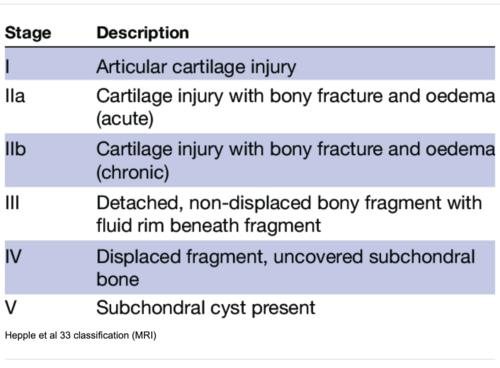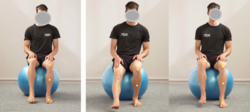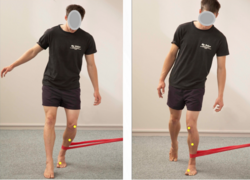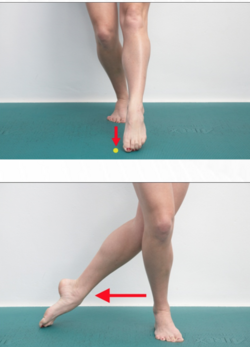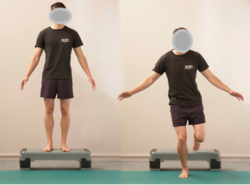Management of Ankle Osteochondral Lesions: Difference between revisions
No edit summary |
No edit summary |
||
| Line 84: | Line 84: | ||
== Clinical Presentation == | == Clinical Presentation == | ||
Patients with | Patients with ankle osteochondral lesions will report deep ankle pain associated with weight-bearing, limitations in range of motion, impaired function, stiffness, and feeling of catching and locking. In addition, the patient may experience tenderness and swelling around the medial and lateral ankle. <ref name=":5" />Examination often reveals subtalar and talonavicular joints range of motion restrictions, impaired ligamentous ankle stability and hindfoot malalignment. <ref name=":1" /> <ref name=":5" /> | ||
== Diagnostic Procedures == | == Diagnostic Procedures == | ||
Revision as of 22:48, 5 August 2022
Definitions[edit | edit source]
Cartilage is a connective tissue characterised by three components:[1]
- Polysaccharides ( a cellular component composed of ground substance)
- Fibrous proteins
- Interstitial fluid with water as the main component
Cartilage gets its nutrition via diffusion from surrounding tissues as it has no direct blood supply, lymphatics and nerves.[1] Each of the three cartilaginous tissues has different composition and function, including hyaline, fibrocartilage and elastic cartilage.
- Hyaline cartilage: is a connective tissue located at the ends of bones. Its primary cells are chondrocytes. Their role is to maintain the cartilage extracellular matrix (ECM), which is responsible for the biological and mechanical function of the cartilage. Hyaline cartilage ECM contains:[2]
- Collagen type II (10-20%)
- Proteoglycan (1-10%)
- Water (65-85%)
- Fibrocartilage is a "transitional tissue between hyaline cartilage and dense regular connective tissue such as tendons and ligaments."[1] It contains:
- High levels of type I collagen
- Type II collagen
- Small component of ground substance [1]
- Elastic cartilage: is flexible connective tissue cartilage that can withstand repeated bending.[1] The components of the cartilage are:[1]
- Type II collagen
- Elastic fibres
- Large chondrocytes
Subchondral bone is located below the hyaline cartilage and cement line and is responsible for providing mechanical and nutritional support for cartilage. Its mechanical properties include shock absorption. [3] In addition, the subchondral bone contains vessels that directly interact with the hyaline cartilage layer. The perfusion mechanism of the subchondral bone vessels is responsible for distributing 50% of cartilage nutrients..[4]
Osteochondral lesions (OCL) are defects affecting the structure of the cartilaginous surface and underlying subchondral bone. When the lesion's healing phase begins and tissue forms, the fibrocartilage is often the new tissue, which has mechanical disadvantages to the hyaline. In some cases, hyaline cartilage forms during the repair process, but the mechanism of hyaline vs fibrocartilage formation is unknown.[1]
Healing of OCL[edit | edit source]
Osteochondral lesions have poor healing capacity. [5] The study completed in animals[6] demonstrates the following stages of healing in the OCL:[5]
Week 1-2: Initial fibrin repair, the damaged site begins to fill with a blood clot and fibrous tissue, mesenchymal cell recruitment initiates
Week 4-8: Cartilage formation starts adjacent to the damaged cartilage
Weeks 8 -12: Bone formation begins through endochondral ossification
Week 18: New bone formation continues
Week 26: Completion of the healing process
OCL Aetiology[edit | edit source]
The aetiology of the osteochondral lesion can be:
- traumatic (80% of cases)[7]
- joint malalignments[8]
- ligament laxity (38% of patients)[7]
- instability (39% of patients)[7]
- genetic predisposition[8]
- endocrine factors[7][8]
- avascular necrosis[8]
- metabolic factors[7]
There are three types of trauma leading to the development of OCL: compaction, shearing or avulsion.
Osteochondral Lesion of the Ankle[edit | edit source]
According to Ferkel et al.,[9] a high percentage of patients with lateral ankle instability developed intra-articular pathology. In the ankle joint, the osteochondral lesion is present in the talar. The osteochondral lesion of the talar cartilage (OCT) and subchondral bone can cause a partial or complete detachment of the fragment. There are six categories of the lesion:
- chondral (cartilage only)
- chondral-subchondral (cartilage and bone)
- subchondral (intact overlying cartilage)
- cystic
In addition to the above lesion categories, OCT can be stable or unstable, non-displaced or displaced.
Classification System for OCT[edit | edit source]
- Berndt and Harty[10] classification system for radiographic staging of osteochondral lesions of the talus. It applies to traumatic and non-traumatic aetiology of the lesion:[11]
- Stage I: with the foot in an inverted position, the lateral border is compressed against the face of the fibula, and the collateral ligament remains intact.
- Stage II: with progressive foot inversion, the lateral ligament is ruptured, and the avulsion of the chip begins
- Stage III: the chip is fully detached but remains in place
- Stage IV: displacement of a detached fragment following inversion
- Loomer et al.[12] added a Stage V to Berndt and Harty classification system:[11]
- Stage I -IV as above
- Stage V: the presence of a subchondral cyst.
- Ferkel and Sgaglione [13] developed a classification system based on computed tomography (CT):
- Stage I: Cystic lesion with the dome of the talus (intact roof)
- Stage IIa: Cystic lesion with communication to the talar dome surface
- Stage IIb: Open articular surface lesion with overlying undisplaced fragment
- Stage III: Undisplaced lesion with lucency
- Stage IV: Displaced fragment[14]
Clinical Presentation[edit | edit source]
Patients with ankle osteochondral lesions will report deep ankle pain associated with weight-bearing, limitations in range of motion, impaired function, stiffness, and feeling of catching and locking. In addition, the patient may experience tenderness and swelling around the medial and lateral ankle. [7]Examination often reveals subtalar and talonavicular joints range of motion restrictions, impaired ligamentous ankle stability and hindfoot malalignment. [11] [7]
Diagnostic Procedures[edit | edit source]
- AP and lateral X-ray completed in a weight-bearing position. [7]
- MRI captures the integrity of soft tissue and subchondral cancellous bone. [16]
- CT allows a better resolution of bony pathologies but offers less information on articular cartilage wear and soft tissues.[7]
- SPECT CT enables information received from both MRI and CT. Caution: the amount of radiation the patient is exposed to by having this procedure.[7]
- Ankle arthroscopy allows for direct visualisation of the entire joint. [7]
Outcome Measures[edit | edit source]
- Lower Extremity Functional Scale (LEFS)
- Foot and Ankle Ability Measure (FAAM)
- The Foot & Ankle Disability Index Score (FADI)
- Foot Function Index (FFI)
Comprehensive Rehabilitation[edit | edit source]
General principles in rehabilitation management[edit | edit source]
There is a lack of high-quality evidence for a specific treatment protocol for managing the ankle osteochondral lesion. [17] Therefore, when establishing goals, planning the treatment and choosing the interventions, the clinician must consider the biological phases of healing. Rehabilitation will also depend on the size of the lesion and its location. In general, rehabilitation program should:
- Be comprehensive and include multi-modal functional training
- Include a minimum of six weeks of supervised rehabilitation training
- Address postural control, balance and proprioception retraining
- Incorporate the entire kinetic chain to improve overall strength
- Include activities to maintain a range of movement
- Include measures to protect the ankle joint by making the patient wear a lace-up brace
- Continue to monitor the patient for an unexplained increase in pain for up to 2 years
Special Concerns[edit | edit source]
In the management of osteochondral lesions, the following rehabilitation considerations must apply:[17]
- Avoid shear forces
- Avoid comprehensive forces
- Adequate pacing of the activities due to slow recovery
- Monitor pain
- Prevent the development of the compensatory movements
Shear forces[edit | edit source]
Shear forces are often the underlying cause of OCL in chronic ankle instability.
Avoid shear forces for over three months. [17]
Compressive forces[edit | edit source]
Fibrocartilage is not as strong as hyaline cartilage.
Delay full weight bearing for as long as six weeks, based on specific clinical factors.[17]
Slow Recovery[edit | edit source]
Repair of cartilage takes time.
Take it easy with steps 1 and 2 and maintain partial weight bearing.[17]
Monitor pain[edit | edit source]
Individualise treatment and respect patient's pain. [17]
Compensatory movements[edit | edit source]
Correct faulty motor patterns. [17]
Ankle Osteochondral Lesions Treatment Strategies[17][edit | edit source]
Stage 1[edit | edit source]
- Take it EASY
- Move the talocrural joints, but DO NOT compress or shear
- Incorporate cardiovascular fitness
- Maintain partial weight bearing
Examples of exercises:
Stage 2[edit | edit source]
- This phase focuses on function
- It is considered a pre-participation phase
- Focus on details
- Progress from partial to full weight bearing and standing on two feet
- Progress in load and complexity of the movement
Example of exercise:
Stage 3[edit | edit source]
- Fitness activities
Examples of exercises:
Before proceeding to stage 4 patient must:
- Receive good scores on Star Excursion Balance Test(SEBT)
- Have pain-free full range of loaded dorsiflexion
- Perform a single hop test without pain and in good alignment
- Demonstate reasonable motor control in posterior medial movement
Stage 4[edit | edit source]
Resources[edit | edit source]
- Saccomanni B. Osteochondral Lesions of Talus: A Comprehensive Review. Mathews J Orthop. 2018; 3(1): 021.
- Hannon CP, Smyth NA, Murawski CD, Savage-Elliott I, Deyer TW, Calder JD, Kennedy JG. Osteochondral lesions of the talus: aspects of current management. Bone Joint J. 2014 Feb;96-B(2):164-71.
References[edit | edit source]
- ↑ 1.0 1.1 1.2 1.3 1.4 1.5 1.6 Armiento AR, Alini M, Stoddart MJ. Articular fibrocartilage - Why does hyaline cartilage fail to repair? Adv Drug Deliv Rev. 2019 Jun;146:289-305.
- ↑ Lakin BA, Snyder BD, Grinstaff MW. Assessing cartilage biomechanical properties: techniques for evaluating the functional performance of cartilage in health and disease. Annual review of biomedical engineering. 2017 Jun 21;19:27-55.
- ↑ Hu Y, Chen X, Wang S, Jing Y, Su J. Subchondral bone microenvironment in osteoarthritis and pain. Bone research. 2021 Mar 17;9(1):1-3.
- ↑ Imhof H, Sulzbacher I, Grampp S, Czerny C, Youssefzadeh S, Kainberger F. Subchondral bone and cartilage disease: a rediscovered functional unit. Investigative radiology. 2000 Oct 1;35(10):581-8.
- ↑ 5.0 5.1 Lydon H, Getgood A, Henson FMD. Healing of Osteochondral Defects via Endochondral Ossification in an Ovine Model. Cartilage. 2019 Jan;10(1):94-101.
- ↑ Shapiro F, Koide S, Glimcher MJ. Cell origin and differentiation in the repair of full-thickness defects of articular cartilage. J Bone Joint Surg Am. 1993 Apr;75(4):532-53.
- ↑ 7.00 7.01 7.02 7.03 7.04 7.05 7.06 7.07 7.08 7.09 7.10 Krause F, Anwander H. Osteochondral lesion of the talus: still a problem?. EFORT open reviews. 2022 Jun 1;7(6):337-43.
- ↑ 8.0 8.1 8.2 8.3 Mosca M, Grassi A, Caravelli S. Osteochondral Lesions of Ankle and Knee. Will Future Treatments Really Be Represented by Custom-Made Metal Implants?. Journal of Clinical Medicine. 2022 Jul 1;11(13):3817.
- ↑ Ferkel RD, Chams RN. Chronic lateral instability: arthroscopic findings and long-term results. Foot Ankle Int. 2007 Jan;28(1):24-31.
- ↑ BERNDT AL, HARTY M. Transchondral fractures (osteochondritis dissecans) of the talus. J Bone Joint Surg Am. 1959 Sep;41-A:988-1020.
- ↑ 11.0 11.1 11.2 Badekas T, Takvorian M, Souras N. Treatment principles for osteochondral lesions in foot and ankle. Int Orthop. 2013 Sep;37(9):1697-706.
- ↑ Loomer R, Fisher C, Lloyd-Smith R, Sisler J, Cooney T. Osteochondral lesions of the talus. Am J Sports Med. 1993 Jan-Feb;21(1):13-9.
- ↑ Ferkel RD, Sgaglione NA, DelPizzo W. Arthroscopic treatment of osteochondral lesions of the talus: long-term results. Orthop Trans. 1990;14:172–173.
- ↑ 14.0 14.1 Elghawy AA, Sesin C, Rosselli M. Osteochondral defects of the talus with a focus on platelet-rich plasma as a potential treatment option: a review. BMJ Open Sport Exerc Med. 2018 Feb 1;4(1):e000318.
- ↑ Hepple S, Winson IG, Glew D. Osteochondral lesions of the talus: a revised classification. Foot Ankle Int. 1999 Dec;20(12):789-93.
- ↑ Sophia Fox AJ, Bedi A, Rodeo SA. The basic science of articular cartilage: structure, composition, and function. Sports Health. 2009 Nov;1(6):461-8.
- ↑ 17.0 17.1 17.2 17.3 17.4 17.5 17.6 17.7 Simpson H. Osteochondral Lesions Course. Physioplus 2022
